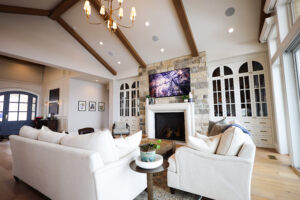If you want to build or remodel your home audio setup, you need to consider the type of speakers that would work best in your space. Do you go for traditional standard speakers, sleek small aperture options, or the ultra-discreet invisible speakers? Each option has its pros and cons depending on your room’s acoustics, design preferences, and budget. In this post, we’ll break down the differences between these speaker types to help you decide which one fits best for your home.
Understanding the Basics of Standard, Small Aperture, and Invisible Speakers
Selecting the right type of speaker depends on a few factors, including the purpose of the room, the desired sound quality, and aesthetic preferences. Each category has characteristics that make it better suited for certain uses. Below, we provide an overview of each type so you can make an informed choice.
Standard Speakers
Standard speakers, whether floor-standing, bookshelf, or in-wall units, are the traditional option for home audio systems. These speakers are valued for their performance and flexibility, with countless models available across different price points. They come in 2.1, 5.1, and 7.1 surround sound setups for those who want immersive home theater experiences.
Standard speakers typically offer the best sound quality, with a full range of frequencies. They are ideal for dedicated listening spaces or movie rooms where sound performance matters more than aesthetics. With separate drivers for low, mid, and high frequencies, these speakers deliver detailed soundscapes that make you feel like you’re part of the action.
Pros and Cons:
Pros:
- Widely available across various budgets and brands.
- Excellent for audiophiles who want precise sound control.
- Simple installation—place the speakers, plug them in, and enjoy.
Cons:
- Can occupy floor or shelf space, cluttering your room.
- Visible wires may disrupt minimal or modern interior designs.
These speakers are the go-to choice for home theaters, media rooms, or living rooms where aesthetics are secondary to audio performance. They are also ideal for users who prefer easy installation with minimal construction work.
Small Aperture Speakers
Small aperture speakers are designed to offer discreet sound solutions without sacrificing too much performance. These speakers are installed in walls or ceilings, with small, subtle grilles that blend into the decor. While not as powerful as standard speakers, small aperture models still deliver excellent sound quality.
Despite their small size, these speakers pack a punch. Brands like Sonance have pioneered the technology to ensure that even smaller speaker openings can produce room-filling sound. These models are also highly customizable—the grilles can be painted to match the walls, making them almost unnoticeable.
Pros and Cons:
Pros:
- Minimal visual footprint, ideal for spaces where design is a priority.
- Efficient use of wall or ceiling space.
- Professional-grade sound quality in a discreet form factor.
Cons:
- More expensive than standard speakers due to specialized installation.
- Some limitations in low-frequency response compared to larger speakers.
Small aperture speakers are best for living rooms, offices, or smaller entertainment rooms, where you want good sound without bulky equipment. They are also great for open-concept spaces where maintaining a clean aesthetic is important.
Invisible Speakers
Invisible speakers take discretion to the next level. These units are installed behind drywall, paint, or wallpaper, becoming completely invisible to the eye. They offer the perfect solution for homeowners who want high-end audio systems without any visible hardware. AIS partners with Sonance, a leader in invisible audio technology, to provide top-tier solutions for luxury spaces.
These speakers rely on vibration panel technology to deliver sound through the surface material, offering surprisingly good audio despite their hidden design. While the audio quality may not match that of larger, visible speakers, invisible subwoofers can be integrated to provide deep, immersive bass. Installation requires careful collaboration between builders, drywallers, and painters to ensure a flawless finish.
Unique Advantages:
- Flexible Placement: Because invisible speakers don’t require symmetrical placement, they work well in irregular spaces or in rooms with vaulted ceilings.
- Wall Integration: Instead of cluttering high ceilings with speakers, invisible units can be placed in walls—a smart solution for architectural spaces or homes with modern interiors.
Pros and Cons:
Pros:
- The most aesthetically pleasing option—no visible speakers or wires.
- Perfect for high-end or custom-designed homes.
- Subwoofers can be added for a complete audio experience.
Cons:
- Expensive and labor-intensive installation.
- Audio quality depends on the material covering the speakers.
- Repairs can be challenging due to the hidden installation.
Invisible speakers are ideal for luxury homes, museums, art galleries, or any space where aesthetics are paramount. They also shine in oddly shaped rooms, as their placement is not constrained by symmetry or spacing requirements.
Each of these speaker options offers unique benefits and limitations, making them right for different situations. However, as technology continues to advance, we can expect to see even more innovative solutions that cater to both the audio quality and design preferences of consumers. Whether you prioritize performance or aesthetics, there is a speaker option out there for everyone.
How to Choose the Right Home Audio Speakers
Choosing the right speakers involves balancing audio quality, design, and budget. Here are some tips to help you find the perfect solution for your home:
- Evaluate Your Room Layout and Usage
- For dedicated theaters or media rooms, opt for standard speakers to get the best performance.
- If the room serves multiple purposes (like an office or living room), small aperture speakers offer a blend of good sound and subtle design.
- For high ceilings or modern interiors, invisible speakers provide a seamless solution that avoids visual clutter.
- Consider Aesthetic Preferences
- If maintaining a minimalist look is important, choose small aperture or invisible speakers.
- If visible equipment isn’t an issue, standard speakers deliver better performance with less hassle.
- Plan for Long-Term Use
- Invisible speakers are ideal for homeowners planning a long-term investment in custom interiors.
- Standard speakers offer more flexibility if you foresee moving or upgrading your system frequently.
- Budget for Installation
- Standard speakers are the easiest and most affordable to install.
- Small aperture and invisible speakers require professional installation, which increases the overall cost. Make sure to factor in labor and finishing costs when planning your budget.
Choosing the right speaker system depends on your personal preferences, budget, and room design. Standard speakers provide unbeatable performance, while small aperture and invisible speakers offer a more discreet, design-friendly alternative. If you want to combine top-tier sound with seamless aesthetics, invisible speakers—with the addition of subwoofers—might be the best fit.
Whatever your needs, AIS is here to help you make the right choice and create the ultimate home audio experience.
Need Help Choosing or Installing Home Audio Speakers? AIS is Here to Help
Choosing the right speaker is a blend of personal preference, budget, and room design. Standard speakers may offer unbeatable sound quality, but small aperture or invisible speakers can elevate the look and feel of your space without sacrificing too much on performance. If you’re unsure which direction to go, don’t hesitate to reach out to AIS for personalized advice and a quote tailored to your home audio needs. We’re here to help you create the ultimate sound experience. Contact us today to learn more.



